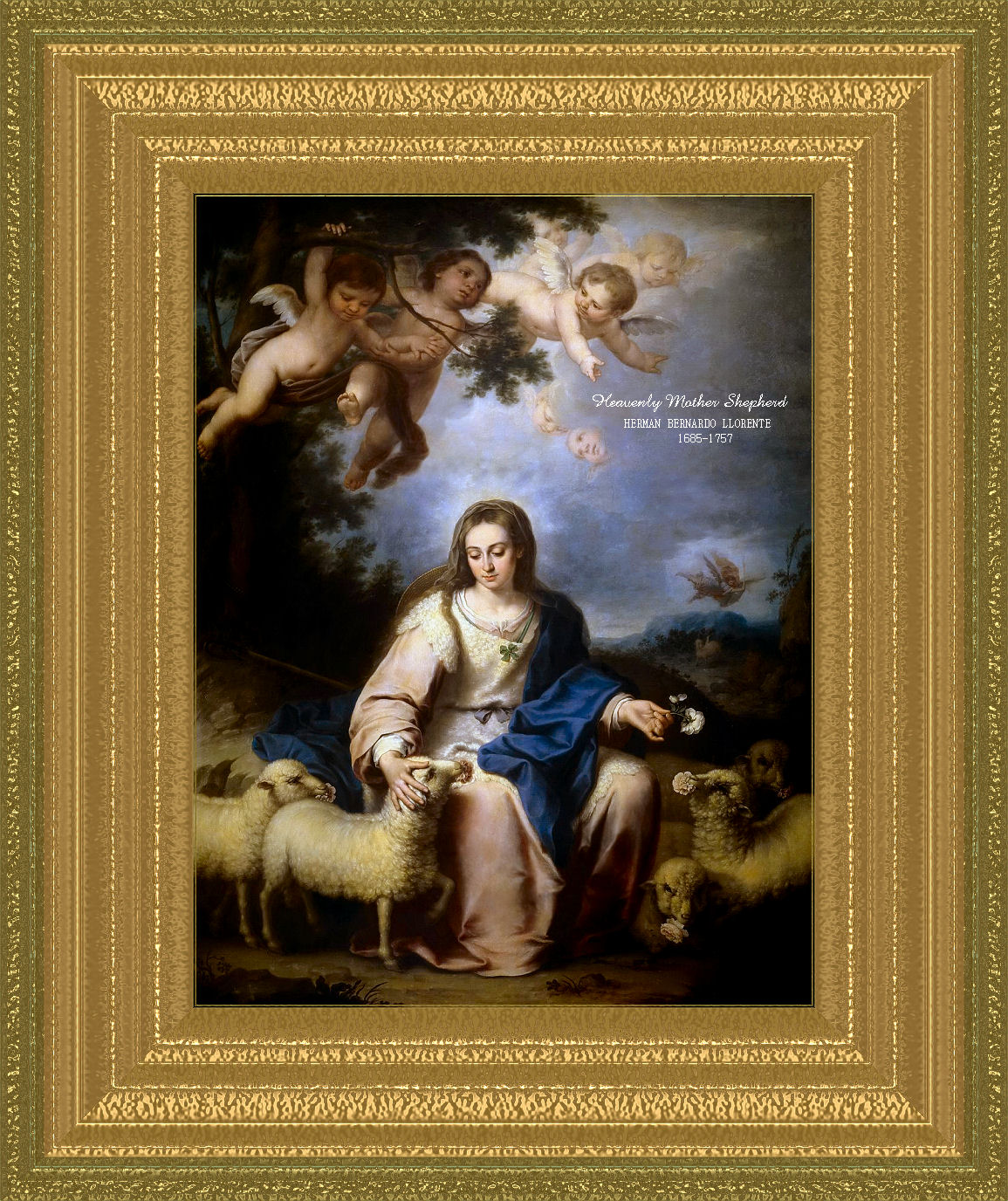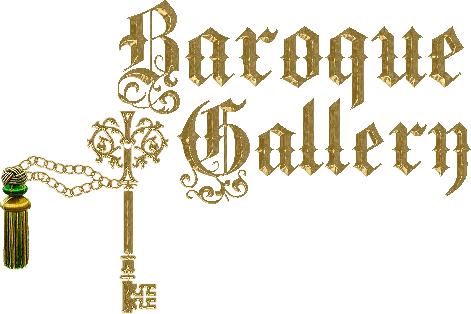  We have expanded this gallery to include four wings with considerably improved images. The Baroque period in art and architecture followed the Renaissance, approximately from the mid 1500s, overlapping the Renaissance until the mid 1800s. Some experts give the mid 1700s as the end of the period, but a number of them have extended the timeline to include the early 1800s. Officially it is characterized by ornate details, although many of the artists do not fit this classification, especially the Spanish painters. The hallmark of the period is emotion, rather than the stylized effect of the previous Renaissance. This occurred because the original Baroque movement was a reaction to the Protestant revolution or Counter-reformation, in defense of the Council of Trent and Catholic apologists from that time forward. One well known such artist was Domenichino. Most Baroque artists who painted religious figures were Catholic, but there are exemptions, such as Rembrandt. Some of the works of the late 1700s and into the mid 1800, bridge the overlapping period between the Baroque and the subsequent Neo-Classic period. Interspersed between these styles arose what was called the Nazarene or Biblical period, Protestant religious painting. While these artists are not officially listed under the banner of Baroque, they occurred just at the onset of the Neo-Classic style and since the artists themselves were born during the late Baroque period, we have chosen to include a few of these so that you can compare them with what preceded their work, because they were influenced by the later Baroque masters. In general, the Baroque works of the Protestants were secular and those of the Catholics, religious and highly emotive inspiring the Faith. Baroque means irregularly-shaped pearl, from barocco in Portuguese, first used during the mid-1700s.The term does not have any relation with pearls but is an epithet for a style that did not comply with the artistic standards of the preceding Renaissance era, tending to awe with grandeur. Near the end of the period a sub-specialty, referred to as rococo [roccoco alt.], developed in France. The artist François Boucher belongs to this genre. The style was so popular that even Protestant artists, from Northern Europe, mainly, adapted it for their own. Baroque art began in Italy and spread north throughout most of Europe. One of its Italian originators was Michelangelo da Caravaggio (1565-1609), whose bold and "light-bathed naturalism" impressed many northern artists. The Italian influence was evident in the works of Peter Paul Rubens (1557-1640), a prolific Flemish artist. Dutch painting of this period was sober, detailed, and warmly soft in the use of colors, such as yellows and browns. Bartolomé Murillo's year of birth is either given as 1616 or 1617. It is generally accepted that it was 1617, however some biographies use the term circa in reference to the year before, 1616. We have used both years, depending on the citation that went with an image used in this presentation. THE EXHIBIT: WEST WING ---------------- THE EXHIBIT: EAST WING ------------------ THE EXHIBIT: NORTH WING --------------- THE SOUTH WING ABOUT THE BANNER IMAGE East Wing THE EXHIBIT:  Guido Reni, Italian: VIEW A PORTRAIT OF THE ARTIST Paintings SAINT JEROME ------- SAINT CECILIA ------- THE REPENTANT SAINT PETER CHRIST WITH THE CROWN OF THORNS ------- CROWN OF THORNS 2 ------- MARTYRDOM OF SAINT APOLLONIA TEARS OF ST. PETER ------- THE REPENTANT MAGDALENE 1 ------- THE REPENTANT MAGDALENE 2 SAINT JAMES THE GREATER ------- SAINT JOHN THE BAPTIST IN THE WILDERNESS ------- THE ANNUNCIATION Bartolomé Esteban Murillo, Spanish: VIEW A PORTRAIT OF THE ARTIST Paintings SAINT ANNE AND THE YOUNG VIRGIN MARY [EDUCATING THE VIRGIN] ------- THE REPENTANT SAINT PETER MADONNA OF THE ROSARY ------- MATER DOLOROSA ------- VIRGIN OF THE ROSARY SAINT JEROME ------- THE CHRIST CHILD ------- MADONNA AND CHILD THE CHRIST CHILD MINISTERING BREAD TO THE PILGRIMS VIRGIN AND CHILD VERSION 1 ------- VIRGIN AND CHILD VERSION 2 THE IMMACULATE CONCEPTION ------- THE VISION OF ST. AUGUSTINE THE RETURN OF THE PRODIGAL ------- THE VISION OF SAINT ANTHONY OF PADUA Peter Paul Rubens, Flemish: VIEW A PORTRAIT OF THE ARTIST Paintings HOLY FAMIY WITH SAINTS ELIZABETH AND FRANCIS ------- ADORATION OF THE MAGI ------- CHRIST CROWNED WITH THORNS MADONNA IN A GARLAND OF FLOWERS Sir Anthony Van Dyck, Flemish: VIEW A PORTRAIT OF THE ARTIST Paintings MADONNA AND CHILD ------- MADONNA AND CHILD WITH ST. CATHERINE ------- PIETA CHRIST AND THE COIN OF TRIBUTE ------- ST. BARTHOLOMEW Giovanni Battista Salvi da Sassoferrato, Italian: VIEW A PORTRAIT OF THE ARTIST Paintings MADONNA AND CHILD WITH BOOK ------- VIRGIN IN PRAYER 1 ------- VIRGIN IN PRAYER 2 VIRGIN IN PRAYER 3 ------- VIRGIN IN PRAYER 4 ------- VIRGIN IN PRAYER 5 MOTHER OF SORROWS ------- THE VIRGIN IN GLORY ------- MADONNA AND CHILD 1 MADONNA AND CHILD 2 ------- VIRGIN AND CHILD 1 ------- VIRGIN WITH SLEEPING CHILD HOLY FAMILY ------- SAINT CECILIA ------- SAINT CATHERINE OF SIENA WITH THE CHRIST CHILD VIRGIN AND CHILD 2 ------- TWO PORTRAITS OF THE YOUNG CHRIST VIRGIN IN PRAYER 6 ------- MADONNA AND CHILD 3 ------- MADONNA AND CHILD 4 THE MYSTIC MARRIAGE OF ST. CATHERINE [ALEXANDRIA] Carlo Dolci, Italian: VIEW A PORTRAIT OF THE ARTIST SAINT CHARLES BORROMEO ------- MATER DOLOROSO ------- DETAIL OF THE FACE OF THE VIRGIN IN GLORY SAINT CASIMIR ------- SAINT JEROME IN PRAYER ------- CHRIST CHILD WITH FLOWERS VIRGIN AND CHILD WITH FLOWERS ------- REDEEMER LITHOGRAPH ------- VIRGIN AND CHILD DETAIL OF THE VIRGIN ANNUNCIATE ------- MADONNA DEL STOFFE AGONY IN THE GARDEN ------- DETAIL FROM THE ANNUNCIATION OF THE ANGEL GABRIEL  ABOUT THE BANNER IMAGE: This painting by Llorente entails all the characteristics of the Baroque period, emotion, attention to detail and a truly Catholic spirit. Our Lady as the Mother of God, denied by some Protestants actually, is depicted here as a loving shepherdess watching over her Son's flock, assisting Him in helping His sheep. Notice how tender she is toward the sheep and the sheep are so docile to her ministrations that they are gently holding her roses in their mouths. One of the interesting details is the placement of the cherubs, which are common in art, descending through the trees, rather than clouds: one of them is embracing the tree branch while supporting the angel above him. There is a manly angel in the background, hovering over a stray sheep, which has wandered dangerously close to a cliff. He is playing music to lead the sheep back from the precipice. Please look at Our Lady's robe: see that she wears a capelet [and apron] of fleece, which represents the flock's gift of prayer to her who is the Mediatrix of all graces. Another symbol of the Trinity is the Irish shamrock [used by St. Patrick when evangelizing the Irish pagans], which is worn like a mantle over her heart by the Blessed Virgin, Spouse of the Holy Trinity. I consider this image to be one of the finest of the period because it is so simple, yet so complete in the lesson it portrays while delighting the eye, the soul, the heart of anyone in love with Almighty God and His Holy Church. There is a hint of a straw hat - the brim is partially visible behind Our Lady's shoulder - the device of adding brimmed hats was quite popular during this period, in particular by the Northern European painters and some of the Spanish, too, although Llorente uses it here. I am glad she is not wearing the hat so nothing mars her veil. I keep this picture in our chapel and like to gaze upon it when saying the Rosary. The Madonna is reminiscent of Murillo's work. That Spanish artist is my favorite Baroque painter because his art is intensely imbued with Catholicism, and was especially devoted to The Virgin and Child and the Holy Rosary. VIEW BANNER IMAGE, LARGER, PLAIN  E-MAIL E-MAIL HOME-----------------------------------DIRECTORIES www.catholictradition.org/Galleries/baroque-gallery.htm |